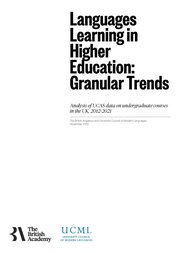Languages Learning in Higher Education: Granular Trends
by the British Academy and the University Council of Modern Languages (UCML)

- Year
- 2022
- Publisher
- The British Academy
- Number of pages
- 20
Summary
This report contains analysis of 10 years of admissions data for undergraduate modern language courses in the UK, using data from the Universities & Colleges Admissions Service (UCAS). This report is an update on previous work carried out in partnership between the British Academy and UCML, published in 2021: ‘Granular Trends in Modern Languages’.[1] This report focuses on degree programmes, but it should be acknowledged that there is a lot of language learning that takes place in higher education that is non-credit-bearing,[2] which is beyond the scope of this report.
Data on language learning in higher education over the past decade shows a complex picture. Exploring the data at a more granular level allows us to better understand some of the changing patterns in how students are applying for and being accepted onto courses, where they are opting to study, and the diverging fate of some individual languages. The findings of this report offer a more nuanced, multi-dimensional picture than the general narrative of decline that is often found in the media in relation to language learning.
It is important to note that the analysis conducted is of admissions data between 2012-2021, during which multiple external factors have influenced on student demand, including departure from the European Union, Covid-19, the introduction of alternative education routes, and changing economic conditions. Most importantly, this period corresponds to a net decline of roughly 76,000 people within the 18-year-old population.[3] The emerging demographic increase in the 18-year-old population - set to last until 2030 - has the potential to mitigate some of the negative trends identified in this report. Policy makers and university leaders should be live to this change in demographics and the potential for trends to shift as a result.
Key findings & observations:
Single subject degrees have declined, while combined and joint degrees are more stable
- Analysis of the JACS subject groups R, “European languages, literature and related”, and T, “non-European languages, literature and related”, demonstrate a downward trend in acceptances to more traditional languages courses. Therefore, to understand the health of languages in undergraduate provision, we need to look more closely at changing patterns of study.
- When looking at the different combinations of language study, a high proportion of the reduction in language learning is found amongst those who are studying single-language degrees, or combinations of languages.
- By comparison, the decline in uptake of degree combinations with a language has been less stark. The numbers of students studying languages with a social science has decreased over ten years, though not to the extent of single study. In contrast, study of a language with an arts or humanities subject has stayed relatively stable over the period, with much smaller reductions in acceptances, until the last year which saw a sharp drop.
Commonly taught languages continue to fall in popularity
- The three most commonly taught European languages – French, German and Spanish - have seen significant decreases in acceptances to courses where a language is named in the title of the degree. These are more pronounced for French and German.
- For Spanish, the percentage decrease is much smaller. However, although pre-university qualifications entries for Spanish have been increasing over recent years, this gain is not translating to higher education. This may point to an issue with conversion/degree choice.
Regional and institutional variations in provision jeopardise access
- There has been considerable variation in language learning by UK region. This threatens the emergence of cold spots in language learning.
- Furthermore, the near disappearance of language learning at post-92 institutions in some regions also has implications for access to language studies.
- There are clear differences in the fate of language learning over the past decade at different university mission groups, and this is more pronounced when factoring in subject combinations.
- The only areas of growth in a system marked by increased competition, when looking from a UK-wide perspective, have been languages courses taught in combination with a social science at Russell Group universities.
[1] https://university-council-modern-languages.org/2021/07/05/ucml-and-british-academy-ucas-report/
[2] University Council Modern Languages, Surveys https://university-council-modern-languages.org/languages-education/621-2/
[3] Office for National Statistics 18 year old population records and projections [accessed 14 October 2022] https://www.ons.gov.uk/peoplepopulationandcommunity/populationandmigration/populationprojections/articles/being18in2018/2018-09-13